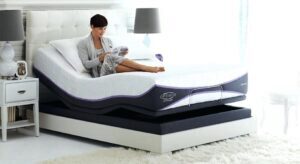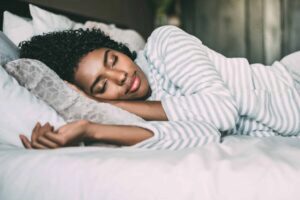Athletes and Sleep Apnea
Disclosure: By clicking on the product links in this article, Mattress Nerd may receive a commission fee at no cost to you, the reader. Read full disclosure statement.
Sleep health is vital for everyone, but the lack of quality sleep from sleep apnea is a rising concern among athletes. Sleep apnea is a disorder that causes you to temporarily stop breathing while you’re asleep. Medical conditions, family history, and lifestyle habits typically put people at risk of developing sleep apnea. But research also shows athletes are even more likely to develop obstructive sleep apnea than the average person.
Sleep Apnea Symptoms
Obstructive sleep apnea (OSA) is the most common form of sleep apnea affecting athletes and non-athletes. As someone with OSA sleeps, their upper airway is temporarily blocked and reduces or completely shuts off the airflow needed to breathe. This blockage is usually caused by surrounding tissue or anatomy of your throat, mouth, or tongue getting in the way.
If you have OSA, you may encounter the following symptoms while you snooze:
- Loud snoring
- Gasping for air
- Breathing stops and starts
- Waking up at night to pee
After you wake up, you may continue to have symptoms that are caused by sleep apnea like:
- Excessive daytime sleepiness
- Trouble focusing or reacting
- Dry mouth
- Morning headaches
- Decreased libido
- Sexual issues
- Anxiety and depression
Sleep Apnea Risk Factors
Several factors increase the general population’s risk of developing sleep apnea, some in and out of your control. Some of the main risk factors for obstructive sleep apnea include:
- Older age: Sleep apnea is more common as people age, and folks over 65 have an increased risk of developing the disorder.
- Being male: Men are more likely than women to have sleep apnea and develop the condition at a younger age.
- Hormonal issues: Hormone fluctuations can alter the shape and size of the face, tongue, and airway.
- Endocrine disorders: People with low thyroid hormone levels, high insulin levels, or high growth hormone levels are more likely to develop sleep apnea.
- Family history of sleep apnea: People are 50 percent more likely to develop sleep apnea if a parent or sibling has the disorder.
- Genetics: Genetics create the face, mouth, and airway anatomy that can cause sleep apnea—so it can be inherited.
- Heart or kidney failure: Fluid build-up in the neck from heart or kidney failure can block the airway.
- Thick neck, large tonsils, or long tongue: A thick neck or large tonsils can narrow the upper airway. Certain tongue positions can also block the airway.
- Alcohol and smoking: Alcohol can relax the throat and mouth muscles, closing the airway. Smoking can lead to upper airway inflammation that restricts breathing.
- Obesity: The most common risk factor for sleep apnea, folks with obesity or higher BMIs have more fat deposits in their neck that can block their airway.
Athletes may be more likely to have OSA because they fit into a few risk buckets, including thick necks, higher BMIs, and being male. Male athletes with sleep-related breathing issues often have wider, more muscular necks and higher BMIs. Researchers especially see this body type and OSA among heavier athletes, like professional rugby and football players.
How Sleep Apnea Impacts Athletic Performance
Sleep apnea can wreck anyone’s sleep quality, but this can be especially detrimental to athletes whose bodies need to recover and respond quickly.
Increases Injury Risk and Slows Recovery
As you sleep, this rest period allows the muscles to recover from fatigue after intense exercise. Sleep plays a role in regenerating and repairing the muscles, which helps prevent muscle injury and soreness. Lack of sleep from sleep apnea can prevent the muscles from fully recovering and increase the risk of injury. An athlete with sleep apnea may also have trouble returning from an injury since lack of sleep can extend the healing time and prevent a full recovery.
Poor Heart Health
In general, folks with OSA have an increased risk of high blood pressure, heart attack, and heart failure. Lackluster sleep can limit an athlete’s aerobic exercise capacity, or the threshold of oxygen the body can use efficiently. This is important for cardio performance and heart health. Athletes with sleep apnea are at an increased risk of sudden cardiac death, especially during athletic events when the heart is working hard.
Slower Reaction Times and Speed
Research shows fatigue can hurt athletic performance even in healthy, non-athlete men by depleting cardiovascular performance. In athletes, this can make it difficult for the body to keep up with intense workouts or activities, making them more tired and less reactive. Physical fatigue from lack of recovery can also make activating muscle groups needed for speed or quick motions more difficult. Poor sleep can also decrease cognitive functions, making it difficult to pay attention, react, or make quick decisions. Athletes may struggle to aim a ball at an intended target, assess the speed of a competitor, or think strategically about a play.
Sleep Apnea Treatments
Before treatment starts, folks typically complete a sleep study to diagnose OSA. Depending on the severity and cause of sleep apnea, your healthcare provider may suggest lifestyle changes or a mix of treatments.
Lifestyle Changes
Adding more physical activity and following a healthier diet is often the first step. Athletes are likely already doing those two things. Still, other lifestyle changes—like focusing on getting 7 to 8 hours of quality sleep—may help. If you’re a back sleeper, sleeping on your side may open your airway. Limiting alcohol and cutting out smoking can also help.
Breathing Devices
A continuous positive airway pressure (CPAP) machine is a popular treatment option for OSA that uses positive airway pressure (PAP) therapy. This breathing device is worn over the nose and creates consistent air pressure in your throat, keeping the airway open while you breathe in and out. An auto-adjusting positive airway pressure (APAP) machine works similarly to a CPAP machine but adjusts the air pressure based on a person’s unique needs. Another device called a bilevel positive airway pressure (BPAP) machine sends high air pressure levels to your airway when you breathe in.
Mouthpieces
Oral appliances or mandibular advancement devices (MAD) can help reposition the jaw or tongue while you sleep. Mandibular repositioning mouthpieces are worn over the top and bottom teeth to prevent the jaw position from blocking your airway. An electrical muscle stimulation device can also be worn for about 20 minutes during the day to help strengthen the tongue and keep it from moving back and blocking your airway while you sleep.
Orofacial Therapy
Exercises that work your facial and mouth muscles can help improve tongue position and strengthen the surrounding muscles. This can help folks control these muscles to help avoid a blocked airway while they sleep.
Surgery
Surgery may be the next step if an athlete has severe sleep apnea and doesn’t respond to other treatments. Surgeries that help correct airway blockage include:
- Removing your tonsils and adenoids
- Implanting devices that monitor breathing and control muscles to open up airways
- Removing soft tissue in the throat and mouth to expand the airway
- Surgically correcting upper and lower jaw alignment and expanding the airway
Takeaway
Athletes, especially contact sports athletes like football and rugby players, are more likely to have obstructive sleep apnea. The exact link between athletes and sleep apnea isn’t fully understood. Still, researchers have found many male athletes often have multiple sleep apnea risk factors, like a thick neck and higher BMI. Poor sleep from sleep apnea can also impact athletic performance by decreasing speed, reaction time, and muscle recovery.
Source List
Caia J, et al. (2020). Obstructive Sleep Apnea in Professional Rugby League Athletes: An Exploratory Study. https://www.jsams.org/article/S1440-2440(19)31665-2/fulltext
Castelli L, et al. (2022). Effect of Sleep and Fatigue on Cardiovascular Performance in Ypung, Healthy Subjects. https://www.sciencedirect.com/science/article/abs/pii/S0031938422002694
Chennaoui M, et al. (2021). How Does Sleep Help Recovery from Exercise-induced Muscle Injuries? https://www.sciencedirect.com/science/article/abs/pii/S1440244021001328
Ernst G, et al. (2019). Increase in the Frequency of Obstructive Sleep Apnea in Elderly People. https://www.ncbi.nlm.nih.gov/pmc/articles/PMC6932834/
FDA Authorizes Marketing of Novel Device to Reduce Snoring and Mild Obstructive Sleep Apnea in Patients 18 Years and Older. (2021). https://www.fda.gov/news-events/press-announcements/fda-authorizes-marketing-novel-device-reduce-snoring-and-mild-obstructive-sleep-apnea-patients-18
Mendelson M, et al. (2018). Maximal Exercise Capacity in Patients with Obstructive Sleep Apnoea Syndrome: A Systematic Review and Meta-analysis. https://erj.ersjournals.com/content/51/6/1702697
Montero A, et al. (2022). Sleep and Mental Health Issues in Current and Former Athletes: A Mini Review. https://www.ncbi.nlm.nih.gov/pmc/articles/PMC9023010/#!po=8.33333
Peck B, et al. (2019). Examination of Risk for Sleep-Disordered Breathing Among College Football Players. https://pubmed.ncbi.nlm.nih.gov/29035666/
Pelliccia A, et al. (2020). 2020 ESC Guidelines on sports cardiology and exercise in patients with cardiovascular disease: The Task Force on sports cardiology and exercise in patients with cardiovascular disease of the European Society of Cardiology (ESC). https://academic.oup.com/eurheartj/article/42/1/17/5898937
Rogers AJ, et al. (2017). Obstructive Sleep Apnea among Players in the National Football League: A Scoping Review. https://www.ncbi.nlm.nih.gov/pmc/articles/PMC6035001/
Sleep Apnea. (2021). https://medlineplus.gov/sleepapnea.html
Sleep Apnea. (2023). https://www.ninds.nih.gov/health-information/disorders/sleep-apnea
Sleep Apnea Causes and Risk Factors. (2022). https://www.nhlbi.nih.gov/health/sleep-apnea/causes
Sleep Apnea Symptoms. (2022). https://www.nhlbi.nih.gov/health/sleep-apnea/symptoms
Sleep Apnea Treatment. (2023). https://www.nhlbi.nih.gov/health/sleep-apnea/treatment
Slowik JM, et al. (2022). Obstructive Sleep Apnea. https://www.ncbi.nlm.nih.gov/books/NBK459252/
Yeghiazarians Y, et al. (2021). Obstructive Sleep Apnea and Cardiovascular Disease: A Scientific Statement From the American Heart Association. https://www.ahajournals.org/doi/10.1161/CIR.0000000000000988

